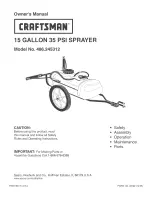
EN
130
EN
131
Technical Data
Troubleshooting
Nominal voltage
220-240 V / ~50 Hz
Rated power
500 W
Max. viscosity
100 DIN-s
Container capacity
800 ml
Flow rate
Nozzle size
Flow rate
ø 1.8 mm
330 ml/min
ø 2.6 mm
900 ml/min
Protection Class
/ II
Sound pressure level (L
pA
)
82 dB(A) / Uncertainty K = 3 dB(A)
Sound power level (L
WA
)
93 dB(A) / Uncertainty K = 3 dB(A)
Max. vibration emission
< 2.5 m/s
2
/ Uncertainty K = 1.5 m/s
2
No emission of
coating material
Nozzle / Feed tube clogged
Material volume setting turned too far down (-)
Feed tube loose
No pressure in container
Clean
Turn up (+)
Insert
Tighten container
Coating material
drips from nozzle
Nozzle loose
Nozzle or nozzle seal worn
Coating material build up on air cap, nozzle or
needle
Tighten
Change
Clean
Atomisation too
coarse
Too high viscosity of material
Material volume setting turned too far up (+)
Nozzle contaminated
Air filter heavily soiled
Too little pressure in container
Thin material
Turn down (-)
Clean
Change
Tighten container
Spray jet pulsates
Container empty
Air filter soiled
Refill
Change
Care & Maintenance
Caution!
Make sure the tool is
switched off and unplugged.
- Clean air cap, nozzles, feed tube and con-
tainer after every use and particularly if:
- no material emerges
- the material drips
- the atomisation is too coarse
- Always keep the tool clean, dry and free of
oil or grease.
- Wear safety glasses to protect your eyes
whilst cleaning.
- For safe and proper working, always keep
the machine and ventilation slots clean.
- Regularly check to see if any dust or foreign
matter has entered the grills near the mo-
tor and around the on/off switch. Use a soft
brush to remove any accumulated residue.
- If the body of the tool needs cleaning, wipe
it with a soft damp cloth. A mild detergent
can be used but nothing like alcohol, petrol
or other cleaning agent.
- Never use caustic agents to clean plastic
parts.
- Clean and lubricate the sealings at regular
intervals.
- Periodically check the proper fitting of all
parts. These could become loose with time
due to vibration.
Caution!
If the supply cord is dam-
aged, it must be replaced by the
manufacturer or its service agent or simi-
larly qualified person in order to avoid haz-
ard.
Noise & Vibration
The values given in these instructions have
been measured in accordance with a stand-
ardized measurement procedure specified in
EN 60745 & EN 50580 and can be used to
compare tools. It may be used for a prelimi-
nary assessment of exposure.
Warning!
The vibration emission
during actual use can differ from the
declared total value depending on the use
of the tool.
Warning!
It is necessary to identify
safety measures to protect the op-
erator that are based on an estimation of
exposure in the actual conditions of use
(taking account of all parts of the operating
cycle such as the times when the tool is
switched off and when it is running idle in
addition to the trigger time).
Try to minimize the impact of vibration and
noise. Exemplary measures to reduce vibra-
tion exposure include wearing gloves while
using the tool, limiting working time, and using
accessories in good condition.



































